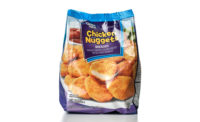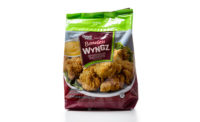One of the dominant packaging formats in protein-processing today is form-fill-seal, and why not?
It checks all of the boxes for processors, retailers and shoppers alike. It is a versatile packaging style that delivers impressive throughput in production and presents important product and brand information on the package in a time when weight and price alone do not cut it for savvy shoppers. In the retail case, it is hard to top for striking graphics and space efficiency.
The majority of processors rely on horizontal, thermoform roll-stock systems, particularly for fresh, refrigerated products. But with the freezer case, the focus shifts to vertical form-fill-seal with applications such as pre-cooked prepared items and meal kits. Virtually all of them, even those that look like stand-up pouches, are run on simple drop-fill vertical machines. The expanding sphere of form-fill-seal seems inescapable.
“If you look at the whole refrigerated protein case, it’s (form-fill-seal) probably growing kind of like the base market: on average, 2 to 4 percent annually,” says an experienced packaging source. But it appears that certain market segments may be growing faster. More and more products, especially smaller consumer portions that once were overwrapped in store, are going to a vacuum roll-stock package.
“Take a look at the number of beef cuts, specialty ground meats — organic, grass-fed, bison — all those products are differentiating themselves by going into a roll-stock package.”
It serves club stores well, too. Multiple portion units can go into a single, big package like a saddle-pack. Whether they are pre-cut poultry, ground beef or other portions, it gives processors the production efficiency to produce packages that hold a volume of product that hits the price club stores want. Shoppers win here too because they have the flexibility to use the portion they choose and the convenience of freezing the rest for future use.
While the base roll-stock materials have not changed much over the last five to 10 years, the ways they are used have. There are more options available for visually dramatic top web graphics like fully matte appearance or registered matte where a part is glossy and part is matte. Parchment presentations that make the package look like old world butcher paper and pigmented webs with bright colors add to the products’ appeal to shoppers.
Despite its seemingly remarkable appetite for adaptation, the roll-stock business is viewed by the marketplace as a “near” commodity, the source says. Differentiation comes from offering a selection of specialty roll-stock products such as cook-in, thermal applications, high abuse and thick webs. Having auxiliary packaging styles, including bags and trays, to bundle into the mix does not hurt when fighting for business.
Still, thermoform roll stock is the place to be because this is an equipment story as much as one about packaging. There are literally thousands of thermoform machines out there. They, and the expanding variety of applications they run, drive film requirements creating a mutually beneficial relationship between machine and material. It may not be perfect, but roll stock fits so well within the supply chain and delivers so many consumer benefits that, even in a congested market, there can be lots of winners. NP






Report Abusive Comment